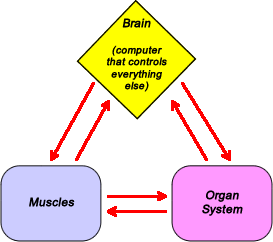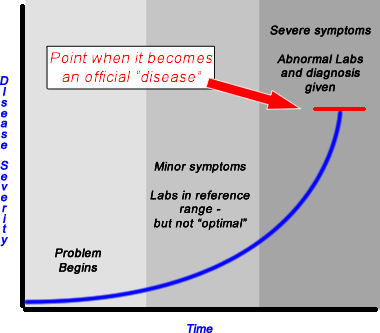Assessment
Case History
A proper case history is essential. Symptoms do not just appear for no reason.
Causes of illness are almost always one of the following:
- Toxicity (including infections)
- Poor nutritional status, or specific deficiencies
- Emotional stress (current or past)
- Physical trauma
Homotoxicology is a model which allows for numerous health events that may seem to be unrelated, to be put together in a context so that relationships are seen. Therefore, detailed histories are always taken, as it's often essential in order to know what to prioritize.
Sample case history
Go to the page on Chronic Fatigue assessment for a case history example of various assessment techniques, plus modalities used together for a complicated case.
In Office Assessment
Muscle Testing
Applied Kinesiology is a system which uses manual muscle tests to assess and treat underlining dysfunctions in the body. This technique - originally started by chiropractor George Goodheart in the 1960's has since spread around the world. There are many systems that use manual muscle testing which have branched off of Applied Kinesiology.
A simple way to understand how muscle testing works is to think of the brain as a computer.
This "computer" is constantly sending electrical signals - through the nervous system - to all 639 muscles in the body. Even you're not doing anything to move the muscle at the moment, this communication still goes on every second. The brain sends a signal to muscles, and the muscles then send a signal back to the brain.
When there is some stress going on, this signal can become overloaded and the muscle then goes weak on a manual muscle test. Since the brain is not just in communication with muscle, but organ systems - and those organs are in communication with muscles, a weakness in one area can effect the other.

In systems that use manual muscle testing - such as Applied Kinesiology, or Touch for Health - there are known associations between various muscle groups and organ systems.
For example, the anterior deltoid is associated with the gallbladder. Therefore if the anterior deltoid is weak, that may indicated a problem with the gallbladder.
Another way muscle testing can be used it to search for food allergies. If exposed to a substance that the body has lack of tolerance for, it can momentary cause a weakness in this communication between brain and muscles. A weakness then may be found on manual muscle test.
There are numerous techniques which have been developed using manual muscle testing. Some examples are:
- Uncover areas of weakness - such as organ systems which are struggling
- Challenge body to see what it needs to fix the problem
- Uncover possible allergies or substances body has lack of tolerance against
- Uncover emotional blocks (this is done with NET - neuroemotional technique - https://www.netmindbody.com)
Dr. Marcus has been trained in numerous systems that use manual muscle testing. These are powerful tools which can be used to help people, when of course combined with a good intake, review of lab work, and other assessment techniques.
Disclaimer - muscle testing can not be used to diagnose a disease. For example a weak anterior deltoid muscle may indicated a weakness in the gallbladder. Based upon this, further muscle testing and symptoms gallstones may be suspected. However the specific diagnosis of gallstones (cholelithiasis) is made by ultrasound.
Other Signs
Numerous other in person techniques such as looking at finger nails, tongue analysis, pain on specific reflux points and visual assessment.
Lab Work
In term of working with someone in the natural health field, lab work can be roughly divided into two categories.
- Conventional lab work: tests that just about all MD's will run, and generally covered by insurance
- Functional lab tests. These are specialty tests that conventional MD's generally are not trained in. However, many more holistically minded MD's and other people in natural health often use.
Conventional Blood Tests
In conventional medicine lab are used to diagnose specific disease.
This is not the same as diagnosing the cause of a disease. For example, it can take years for an autoimmune disease to develop. During this time there may be some skewing on conventional labs. However everything will still technically be in the "reference range." There is no diagnosis until a threshold point is hit. All of a sudden the patient who was perfectly "healthy" the day before now has a "disease," and can be treated with drugs or surgery.

Labs tests and established reference ranges are designed only to determine threshold point in which a "disease" officially starts.
Prior to this there may be clues to poor health, even if the results are still in the "reference range." However, this will typically be ignored because things are not yet bad enough. Often established reference ranges are far to large, so labs which indicate a problem are called "normal."
For this reason, it's important to go over labs work (even if it's all "normal") for underlining functional problems.
For example:
- On a complete blood cell count - a CBC of 100 or more indicates macrocytic anemia. This is an problem of too many immature red blood cells cause by a deficiency of vitamin B12, or folate.
- However, functionally speaking, when MCV is over 90, it may be recommended to take B12 and folate. This is because the labs are at this point showing a problem with those two vitamins. However, this is not a diagnosis of "macrocytic anemia," as that by definition is not present until MCV is over 100.
Functional Lab Tests
"Functional labs" is a blanket term for numerous labs tests not generally run in conventional medicine, but often run by more "alternative" practitioners such as; naturopathic doctors, chiropractors, holistic MDs and other people in the field.
Functional lab tests are typically designed to find underlining causes of poor health, whereas conventional labs are better at diagnosing specific diseases.
There are many different types of functional lab tests. These include:
- Saliva hormone tests
- Stool tests (typically tests for many more markers, then conventional parasitology tests)
- Allergy tests
- Various lab tests for toxicity
Although at times functional labs may be useful, it's also important to carefully consider need. Extensive functional lab testing can be expensive, and is not necessarily going to show the real problem. If sufficient information can be gathered from history, a more functional review of prior lab work, and simple in office assessment, then there may not be a need to run lots of special functional lab tests.

